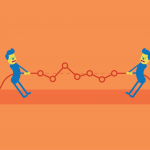
We’ve been hearing about resilience in the corporate world for some time now and a number of organisations, including the Australian Defence Force (ADF), are putting huge dollars into increasing or enhancing the resilience of their workforce. Resilience for our soldiers and war-fighters is clearly a high priority, but it must also be valuable for other organisations and individuals. So what is resilience? Do we have it? And can it be learned?
What is it?
There a lots of definitions floating around. Traditionally applied to the properties of objects or substances, these definitions focus on the ability of those to resume/return to or spring back into their original shape or position – otherwise known as elasticity. In this way, resilience can also apply to the human body ie. the capability of a strained or injured body to recover to its normal form.
In the corporate context, however, we are applying it to an individual’s mental or emotional resilience, specifically, their ability to manage and recover from difficulties, stress or setbacks. At the recent ADF Resilience Forum in April 2016, the Vice Chief of the Defence Force (VCDF), VADM Ray Griggs quoted Jenson and Fraser’s definition of resilience – “the capacity to adapt successfully in the presence of risk and adversity”.
In the past we knew resilience by terms such as mental toughness’ or ‘intestinal fortitude’. Remember the old saying, “They don’t make ‘em like they used to”? or our grand-dad’s old favourite – “back in my day, we used to walk 10 miles to school and back each day in bare feet and thought nothing of it”.
Resilience over the years
Given the changes to our society over the past 50 years, things were incredibly different when my grandparents were in the workforce, and I’d have to agree that we probably did ‘breed them tougher’ back then. But that was out of necessity – life, whilst it may have been simpler in many respects, it was also much tougher in as many ways. Were our ancestors more resilient than us? And are we more resilient than the next generations? Perhaps our predecessors were more resilient than us, but in different ways. They certainly had different challenges and issues to deal with.
Today we struggle with different pressures – competing priorities, maintaining work-life balance, downsizing, doing more with less, continuous improvement, workplace politics etc.
Recent research out of the UK by Sarah Bond and Gillian Shapiro asked employees from public, private, and non-profit organisations about what reduced their resilience or required them to draw on their resilience in the workplace. Nearly 70% reported that overwhelming workloads (volume and pace) were key stressors, with nearly 80% saying that the biggest drain on their resilience was managing difficult relationships and/or politics at work.
Is it innate or can we learn it?
Should organisations be spending their corporate dollars on trying to improve resilience or is it wasted effort? Working with many organisations in this area over the past few years, I believe resilience can certainly be learned or enhanced. Resilience is a process, not a personality trait. It is a choice, heavily influenced by the individual’s interpretation of the situation (or event). Surely this means we can learn new skills and have new experiences that help us apply this process and build our resilience. Isn’t that how our ancestors became more resilient- through their experiences – through dealing with adversity and having to come out the other side intact?
Are we focussing too much on it?
Jane Caro, in her recent article in the AIM magazine titled ‘Resilient evil: are you expected to be endlessly resilient?’ laments the ‘infection’ of the term resilience and other words with the ‘corporate mantra virus’. She says that it is being over-relied upon and starting to be used as a judgement or criticism in the workplace – that we are all meant to be endlessly resilient and if we are not, it is seen as a performance issue.
How is it used in your organisation? Agreed, 20 years ago, resilience wasn’t on the radar in the workplace – we didn’t hear about it in most organisations and it wasn’t part of the HR landscape. However, I haven’t seen it ‘misused’ in any of the organisations I’ve worked with, that’s not to say it’s not happening in some, but I’ve not witnessed it. I think the smart organisations are recognising resilience for what it is, or what it could be, and that enhancing individual resilience for their employees can assist them to manage at work and at play. Of course, those organisations also need to examine the key causes of stress within their workplaces that require employees to call on their resilience, to reduce or even eliminate those triggers where possible.
Resilience as a bucket
In many of the training programs myself and my team conduct, resilience is a key focus for discussion. As I explain to my participants, let’s think about our own resilience like a bucket, and the stress we deal with every day as water filling our bucket. We are all unique and have different shaped and sized buckets. Some people have larger buckets and can handle more water than others.
But the size of your bucket is not the important thing, rather it’ s that you have enough holes (or release valves) in your bucket to let the water out when you need to, so that it can continue to be filled, as it inevitably will because life, with all its ups and downs, continues regardless. As Jane Caro points out, resilience in the face of adversity or a crisis is only possible if people know that the situation is temporary. We have to have release valves or ways of managing the stress and maintaining our resilience so the water isn’t constantly overflowing.
How can we improve our resilience?
There are a number of skills and tools you can use. I think by far the most fundamental and valuable is self-awareness, from which the rest stems. For me this includes helping individuals to understand, be aware of and explore:
- Human instincts in general and our responses to stress;
- Emotional responses in such situations;
- Our individual beliefs and standards and how they influence our perception of reality and our responses to different situations;
- Individual skills and limitations – knowing what drives and motivates us as individual and what pushes our buttons; and finally
- Our present capacity – just how full our individual resilience bucket is at present and why.
Gaining a deeper understanding of the above can enhance our sense-of-self. It can help us define our limitations and have trust and confidence in ourselves to tackle life’s challenges. Other elements of resilience include:
- Adaptability – being able to respond effectively to different experiences and situations.
- Lateral Thinking – viewing a situation from different angles to understand cause and effect.
- Proactiveness – focussing on the benefits of and deciding to learn from challenges.
- Social Connectedness – the quality of our relationships and support networks.
That gives us plenty to work on when it comes to enhancing our own resilience – and perhaps we should be focussing on what comes naturally to us, that is identifying what we’re good at and building on it.






